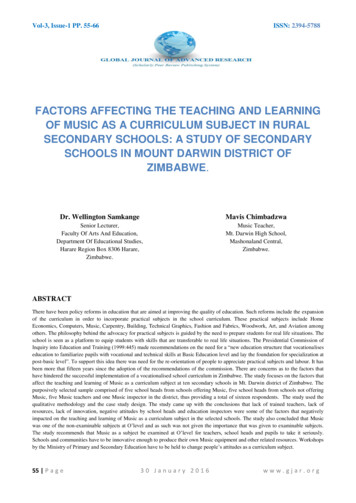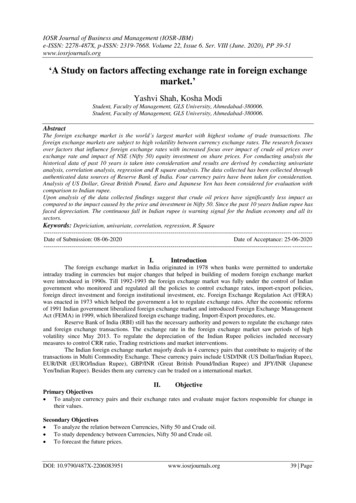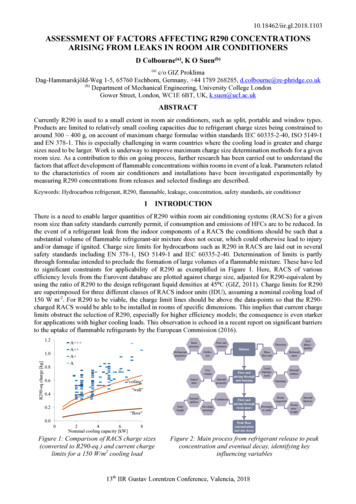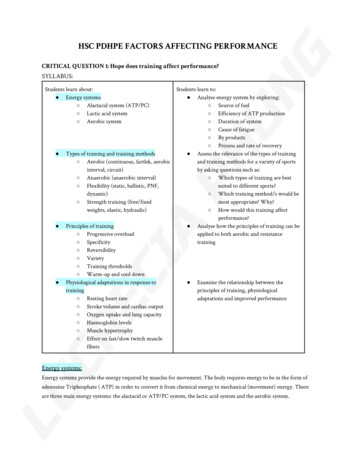
Transcription
HSC PDHPE FACTORS AFFECTING PERFORMANCECRITICAL QUESTION 1: Hope does training affect performance?SYLLABUS:Students learn about: Energy systems Alactacid system (ATP/PC) Lactic acid system Aerobic system Types of training and training methods Aerobic (continuous, fartlek, aerobicinterval, circuit) Anaerobic (anaerobic interval) Flexibility (static, ballistic, PNF,dynamic) Strength training (free/fixedweights, elastic, hydraulic) Principles of training Progressive overload Specificity Reversibility Variety Training thresholds Warm-up and cool downPhysiological adaptations in response totraining Resting heart rate Stroke volume and cardiac output Oxygen uptake and lung capacity Haemoglobin levels Muscle hypertrophy Effect on fast/slow twitch musclefibers Students learn to: Analyse energy system by exploring: Source of fuel Efficiency of ATP production Duration of system Cause of fatigue By products Process and rate of recovery Assess the relevance of the types of trainingand training methods for a variety of sportsby asking questions such as: Which types of training are bestsuited to different sports? Which training method/s would bemost appropriate? Why? How would this training affectperformance? Analyse how the principles of training can beapplied to both aerobic and resistancetraining Examine the relationship between theprinciples of training, physiologicaladaptations and improved performanceEnergy systems:Energy systems provide the energy required by muscles for movement. The body requires energy to be in the form ofadenosine Triphosphate ( ATP) in order to convert it from chemical energy to mechanical (movement) energy. Thereare three main energy systems: the alactacid or ATP/PC system, the lactic acid system and the aerobic system.
Definitions:-Chemical energy: energy from food which is stored in bonds between atoms. A kilojoule measures the energyvalue of food. A calorie is equivalent to 4.2 kilojoules-Resynthesis: the process of restoring ATP to its former state-Adenosine triphosphate (ATP): a high energy compound that stores and transfers energy to body cells,allowing them to perform in their specialised functions; e.g. muscle contractions-Creatine phosphate (CP): an energy rich compound that serves as an alternate energy source for musclecontractionsATP has the ability to quickly rebuild and/or resynthesise, allowing us to continue to function on limited stores. ATPneeds to be continually rebuilt to enable energy flow. If intense physical demands are placed on the body the systemsrespond by producing much higher levels of ATP.Energy system summary:ATP/PCLACTIC ACIDAEROBICSOURCE OF FUELCreatine phosphate (CP)Carbohydrates glucose (blood stream) glycogen (muscles/liver)CarbohydratesFatProteinEFFICIENCY OF ATPPRODUCTIONVery limited if demand is highRapidly available at considerablecostsExtremely efficient 38 ATPparticles per glucoseSYSTEM DURATION10 - 15 seconds (max)30 seconds - 2 minutes at maxintensity1 hour at max intensity to 4-6 hoursat submaximal intensityCAUSE OF FATIGUEInability to resynthesise ADPfrom CPPyruvic acid can not be removed fast enough. Build up of H(hydrogen ions)Increased need for oxygen to convertglycogen to glucose. Fat requiresmore oxygen to convert to glucoseBY-PRODUCTSN/APyruvic acidCarbon dioxide and waterRATE OF RECOVERYWithin 2 minutes30 minutes - 1 hour24 - 48 hoursEXAMPLESExplosive activities, shot put,long jump, high jump400 metre sprint, 200 meterfreestyle, gymnastics routineMarathon, triathlon* submaximal intensity 70% - 80% MHR *DOMS delayed onset muscle sorenessTypes of training and training methods:There are four types of training: Aerobic training: uses the aerobic system as the main energy supply.-Continuous: sustained effort without rest of longer than 20 minutes. Heart rate must rise above the aerobicthreshold. E.g. low paced cycling, marathon. Types of continuous:
long, slow distance training: 60 - 80% MHR high intensity work of moderate duration: 80 - 90% MHR-Fartlek: vary in speed; combination of interval and continuous training; random use of variations in speed andintensity. E.g. basketball, soccer, rugby - suicide runs-Aerobic interval: alternating sessions of work and recovery; can be tailored to the development of both aerobicand anaerobic energy systems; can be easily manipulated to target a specific fitness component. E.g. run 200metres in 35 seconds, rest for 25 seconds, repeat.-Circuit: participants move from one ‘station’ to another, performing specific exercises; can be time dosed orrepetition dosed; results in minimal improvements to aerobic capacity. Progressive overload is easily appliedthough increasing stations, thime, repetitions, load, number of circuits and cutting recovery time. Anaerobic training: uses the two anaerobic energy pathways as the major supply of energy. Activities undertakenneed to have very high intensity, heart rate in excess of 85% of its maximum level-Anaerobic interval: use interval training, often referred to as sprint training; use higher intensity with longerrest breaks. Characterised by brief, maximal activity, generally ranging between 10 seconds to 2 minutes with awork rest ratio of 1:3, meaning for every 10 seconds you work you rest for 30 seconds. Intervals are performedin sets of repetitions designed to overload the anaerobic energy systems. Maximal effort repetitions aredesigned to improve the ATP-PC stores, whereas slightly longer efforts aimed to improve the body’s toleranceto lactic acid. Many teams use anaerobic intervals in their training to develop the speed component. Abalanced training program may need to incorporate speed, acceleration, and power as well as agility. Flexibility: is essential for prevention of injury and decreases muscle soreness, improved coordination betweenmuscle groups, muscular relaxation, reducing the tightening of muscles post exercise, an increased range of movementaround joints maximising performance. Types of flexibility training:-Static: when muscle is stretched to a length that is uncomfortable and held for a given time. G.g. toe touch-Dynamic: an athlete performs movements that take their joints through their ROM. e.g. walking lunge-PNF (proprioceptive neuromuscular facilitation): involves a static stretch, followed by a contraction of thestretched muscle until the stretch no longer felt. E.g. hamstring stretch, requires more than 1 person-Ballistic: stretching that involves bouncing or swinging. E.g. forward leg swingsStretch reflex refers to a muscle contraction in response to stretching. Strength training: the ability of a muscle or group of muscles to exert a force against a resistance. Absolute strength isthe maximum force that can be generated by a muscle, while relative strength is the maximum strength that can begenerated by a muscle relative to one's weight. Types of strength training:-Elastic resistance training: uses various forms of elastic to provide the resistance to develop strength-Free/fixed weights: involves lifting a certain weight against gravity to train specific muscles or groups ofmuscles-Hydraulic resistance training: uses machines, which use water or air compression to provide the resistancethrough the movement
Example for both team and individual sports:SportTraining type and methodBasketball--Surfing--JustificationAerobic- Fartlek suicidesStrength- Free/fixed weights leg pressAerobic- Fartlek training, for example suicides, requires players to varytheir speed at high intensities similar to a proper game. Alsohelps build aerobic systemStrength- Free/fixed weights, allows players to strengthen particularmuscles such as leg muscles in order to keep up with theintensity required in game. For example, leg press can build legmuscles so that athletes are able to create more explosive powerwhile jumping for reboundsFlexibilityAerobic- Aerobic interval training row machine intervalsAnaerobic- Anaerobic interval kickboard intervals- 10 metre fastkicking 40 metrelow intensitykickingFlexibility- Surfers require flexibility to quickly and efficiently stand ontheir board when the right wave comes. By training theirflexibility, it will allow them to do so in an efficient manner sothey can get the most out of the wave.Aerobic/anaerobic- As surfing requires both aerobic and anaerobic systems, it isimportant to train both of them even if they are low intensity.For example, paddling and floating require the aerobic systemeven though they are low intensity. Once on the wave, thesurfer would probably last up to 20 seconds before falling, thusutilising the anaerobic system. They can train their aerobicsystem by doing row machine interval and their anaerobicsystem by doing kickboard intervalsPrinciples of training:A major objective of training is to improve performance. The body has the ability to respond to physiological andenvironmental stressors and to adapt to them - over time and with practice. There are six principles to improveperformance:-Progressive overload: this principle occurs when the training load is greater than normal and is progressivelyincreased as improvements in fitness occurs. aerobic training: reflected in the hearts ability to pump more blood to working muscles (increasedcardiac output) and also the muscles ability to take up more oxygen (increased oxygen uptake) strength training: an increase in the cross-sectional area of the muscle called muscular hypertrophy flexibility training: the ability of a muscle to stretch further than its normal length-Specificity: the effects of a training program are specifically related to the manner in which the program isconducted. The specificity principle implies that greatest gains will be made when activity in the trainingprogram resembles the movements in the game or activity.
aerobic training: an athlete training for a marathon needs to target the aerobic energy system as itis used in races 95% of the time strength training: for a sprint cyclist increased leg power is required so sets, reps, load and time oflifting needs to address this flexibility training: increased flexibility of the shoulder muscles is needed for javelin throwers soeach muscle group of the shoulder needs to be consistently stretched-Reversibility: a cease of or lack of training causes the opposite to occur, known as ‘detraining effect’.Maintenance of training individual fitness components is crucial. aerobic training: effects can be seen 4 - 6 weeks after training stops, can be avoided by maintaining2 sessions of aerobic training per week strength/resistance training: effects can be seen in 2 weeks, can be avoided by maintaining 1session per week-Variety: using the same drills and routines will not be productive, as repetition without creativity leads toboredom aerobic training: can train theis system through many forms such as swimming, running, boxing,cycling and circuit training strength training: can use a variety of methods (circuits/supersets/isometric) and a variety ofequipment (balls/tyers/ropes/sandbags) flexibility training: can use a range of methods including static, PNF, dynamic and ballisticstretching techniques-Training thresholds: thresholds generally refer to a specific point that when passed takes the person to a newlevel anaerobic threshold: refers to the level of intensity in physical activity where the accumulation oflactic acid in the blood increases very quickly aerobic training zone: refers to a level of intensity where the heart rate is high enough to producesignificant training gains. Above aerobic threshold and below anaerobic aerobic threshold: refers to a level of exercise intensity that is sufficient to cause a training effect.This is approximately 70% of a person’s MHR-Warm-up & cool down: the purpose of a warm-up is to reduce the risk of injury or soreness, increase bodytemperature and enzyme activity, mentally prepare athletes, stimulate cardiorespiratory system. The purposeof a cool down is to minimise muscle soreness and stiffnessPhysiological adaptations in response to training:The body makes specific changes to ensure that adequate oxygen and nutrients are being supplied to meet increaseddemand. The 6 physiological adaptations in response to training are:-Resting heart rate: will undergo hypertrophy and become more efficient as a result of training; minimumrequirement for oxygen is reflected by the resting heart rate. The main reason for a fall in resting HR is theincrease in stroke volume. A trained athlete will have a lower resting heart rate compared to an untrainedathlete-Stroke volume and cardiac output:
stroke volume refers to the amount of blood pumped out by the left ventricle per beat. Strokevolume increases during exercise with most of the increase being evident as the individual progresses from restto moderate exercise. Trained athletes have a higher stroke volume at rest and a significantly higher strokevolume during exercise. cardiac output refers to the amount of blood pumped out by the left ventricle per minute. Cardiacoutput increases with exercise similar to stroke volume. Cardiac output for both trained and untrainedindividuals is approximately 5 liters per minute. The stroke volume and hence cardiac output will determinethe amount of blood being circulated.-Oxygen uptake and lung capacity: oxygen uptake refers to the amount of oxygen absorbed into the bloodstream during exercise.Improving this capacity is one of the goals of aerobic training. The oxygen uptake (VO2) of an athlete is theamount of oxygen that the body uses in a minute. Oxygen uptake also improves stroke volume and cardiacoutput as well as greater lung capacity and higher haemoglobin levels within blood. All these capacities, whencombined, allow the increased flow of oxygen-rich blood to working muscles. lung capacity refers to the amount of air that can move in and out of the lungs during one breath.The greater the volume of air that can be inhaled and exhaled as well as faster breathing-Haemoglobin levels: refers to a protein found within red blood cells. Its main function is to absorb oxygen atthe lungs and carry this oxygen to the working muscles. The body adapts to this by producing more red bloodcells and haemoglobin. This will improve the ability of the individual to absorb and deliver oxygen to workingmuscles and this will improve performance in aerobic events.-Muscle hypertrophy: refers to the increase in the diameter of a muscle as a result of strength or resistancetraining, not as a result of aerobic training. The production of more myofibrils causes muscle fibers to enlarge.Muscle hypertrophy will occur if an athlete lifts medium to heavy weights during training.-Effect on fast and slow twitch muscle fibers: the amount of each type of fiber in a muscle will depend on thenormal function and use of the muscle. Undertaking training that is specific to the requirements of your sportwill assist in the development and adaptation of each muscle fiber type. The development of slow twitchmuscle fibers is enhanced through the participation in endurance-type activities. These activities encouragethe creation of capillaries inside the working muscle cells. The development of fast twitch muscle fibers leadsto improvements in aerobic endurance and higher levels of performance. e.g. a long distance runner will have more slow twitch muscle fibers, while a weightlifter or otherpower event athletes will have more fast twitch muscle fibers
CRITICAL QUESTION 2: How can psychology affect performance?SYLLABUS:Students learn about: Motivation Positive and negative Intrinsic and extrinsic Anxiety and arousal Trait and state anxiety Sources of stress Optimum arousal Psychology strategies to enhance motivationand manage anxiety Concentration/attention skills Mentalrehearsal/visualisation/imagery Relaxation techniques goal-settingStudents learn to: Evaluate performance scenarios to determinethe appropriate forms of motivation Explain the difference between anxiety andarousal in terms of the effects on performance Research case studies of athletes fromdifferent sports and ascertain the nature oftheir motivation and the psychologicalstrategies they employMotivation:Research suggests that there is a significant potential to improve sports performance through mental preparations.Motivation is an internal state that activates, directs and sustains behaviour towards achieving a particular goal. It ismotivation that drives you. The types of motivation include:-Positive: occurs when an individual's performance is driven by previous reinforcing behaviours. E.g. an athleteperforms better to receive compliments.-Negative: characterised by an improvement in performance out of fear of the consequences of not performingto expectations. E.g. a player may work hard to avoid being ridiculed post match.-Intrinsic: motivation that comes from within the individual. E.g. an athlete continuing to finish a raceknowing there is no chance of winning-Extrinsic: occurs when the individual’s internal state is modified by sources originating from outside theperson. E.g. money, coach/parental praiseAnxiety and arousal:Anxiety is predominantly a psychological process characterised by fear or apprehension. It disrupts and unsettlesbehaviour by lowering the individual’s concentration and affecting their muscular control, negatively impactingperformance.-Trait anxiety: refers to a general level of stress that is characteristic of an individual; varies according to howindividuals have conditioned. What may cause anxiety and stress in one person may not generate an emotionin another. E.g. exams, grand finals
-State anxiety: refers to a heightened presence of distress in response to a particular situation. It is theemotional response of an athlete to a particular situation. E.g. forgetting movements during a routine, falsestarts in a race. Two variables in state anxiety include: importance of situation (FIBA Basketball World Cup vs street basketball games) uncertainty of the outcome (even competition vs easy opponents)-Managing anxiety: learn to manage anxiety using techniques such as relaxation, hypnotherapy, cognitivebehaviour therapy and positive thinking.-Stress: is produced by adrenaline; left uncontrolled it contributes to anxiety and reduced performance-Sources of stress: personal pressure - individual pressure imposed by the desire to win, achieve or fulfil goals competition pressure - pressure exerted by opponent on the field of play social pressure - pressure from coaches, parents, peers and others who are held high esteem byathletes physical pressure - the pressure of having to perform learned skills under the demands ofcompetitionCharacteristics of stress:Physiological reaction -Increased blood supply to skeletal musclesMore oxygen to lungsIncreased glucose production to provide extrafuelIncreased sweat production to cool bodyTightened muscles to prepare the bodyOur perception of stress is influence by: Past experiencesRoutinesExpectationsThe amount of supportThe frequency of similar occurrencesCoping with stress: practicing relaxation techniques developing concentration skills that require focusing on the immediate task developing confidence planning strategies to cope with the situationArousal is a specific level of anxiety and can be experienced prior to and during performance. Arousal is essentially aphysiological state. psychological: relating to the mid or mental activity physiological: consistent with or characteristics or normal functioning of a living organism-Optimum arousal: the individual performs the skill most successfully when the level of arousal is optimal forthat particular task and that individual. Note: optimal does not mean maximal, here optimal means at the requiredlevel needed to ensure success-Low level of arousal (under arousal): may lead to distraction, disinterest and depressed level of motivation forthe individual-Over-arousal: leads to movements without precision, being excessively tense and unable to concentrate-Moderate arousal (optimal): tends to lead to optimal performanceBoth over-arousal and under-arousal contribute to adverse performance.
Note: low and high levels of arousal generally result in low levels of performance depending on the sport. Optimal arousal results inhigh levels of performance is most ideal for sports. Image above is an inverted-u hypothesis.Generally, when it is a difficult task focusing more on accuracy, levels of arousal need to be lower to be optimal. This isbecause fine movements and/or complex skills require a large amount of our attention to complete tasks and so a lowerarousal level is required. E.g. archer, darts. In other activities that seem simpler but require more speed and strength, ahigher level of arousal is required for performance to be optimal.Factors impacting optimal arousal:-Self expectation: how the individual expects to perform-Expectation by others: how the individual perceives others expect them to perform-Experience: determines how the individual handles the increased pressure at higher levels of competition-Financial pressures: whether the individual’s livelihood depends on their performance-Level of competition: whether the individual is playing a round or final-Degree of difficulty: with lower levels of arousal generally being associated with more difficult tasks-Skills finesse: with fine motor skills vs gross motor skillsPsychology strategies to enhance motivation and manage anxiety:-Concentration/attention skills (focusing): considered a mental process by improving the ability to focus onrelevant cues; e.g. coach - keep your eyes on the ball, and to ignore irrelevant ones; e.g. spectator - you catchlike a baby. Attention describes the process whereby individuals use their senses to perceive what is going onaround them. There are two types of attentional focus strategies: Associative: where the athlete concentrates on bodily functions and feelings e.g. heart rate andbreathing
Dissociative: where the athlete concentrates on external cues e.g. people and environment-Mental rehearsal: the technique of picturing the performance or skill before executing it. positives: help maintain current levels of skill execution, improved concentration, can practicewhen training can not be completed negatives: won't build skills, difficult for the coach to control, may embrace the pictures in anunproductive mannerThe importance of effective mental rehearsal to skill performance is that it: elevates the body to the desired level of arousal provides a clear idea of what has to be done heightens concentration narrows thoughts to be the task-Visualisation/imagery: the focus is on picturing a specific aspect of the performance or skill. The visual imagecan help the performer focus on the movements required to produce an optimal performance, increaseconcentration and confidence.-Relaxation techniques: a series of techniques that seek to control the body’s response to stress; often used tocalm the athlete,decrease anxiety and control levels of arousal. Types of relaxation techniques: progressive muscular relaxation: involves relaxing muscle groups using special exercises (a goodtechnique if arousal is excessive) mental relaxation: relaxing the body through controlled breathing, relaxing the mind and gaining a‘floating feeling’ self-hypnosis: using the power of suggestion to have the mind accept a particular level of anxiety ina specific situation mental rehearsal: concentrating on rehearsing the performance of the task rather than on how youfeel about it meditation: narrowing one’s thoughts using simple repetitive images/sounds centered breathing: controlling breathing to release tension before a performance-Goal setting: goals are targets that we direct our efforts towards. Goals provide athletes with a reason topersevere with training over extended periods. They provide focus, give direction, and help people realizetheir aspirations.types of goals: long term goals: can be achieved only over a long period of time. E.g. complete city to surf fun run,includes years and months short term goals: can be achieved in a limited period of time. E.g. ‘I will complete at least threeendurance training sessions this week’. Includes days and weeks behavioural goals: related to improved behaviour expectations in training, competition or both.They are observable, measurable behaviours rather than aspirations. E.g. be more punctual to training performance goals: goals that relate to an athlete’s desired level of success. E.g. a state, national orOlympic medal
CRITICAL QUESTION 3: How can nutrition and recovery strategies affect performance?SYLLABUS:Students learn about: Nutritional considerations Pre-performance, includingcarbohydrate loading During performance Post performance Supplementation Vitamins/minerals Protein Caffeine Creatine phosphate Recovery strategies Physiological strategies Neural strategies Tissue damage strategies Psychological strategiesStudents learn to: Compare the dietary requirements of athletesin different sports considering pre, duringand post performance needs Critically analyse the evidence for and againstsupplementation for improved performance Research recovery strategies to discern theirmain features and proposed benefits toperformanceNutritional considerations:Nutrition is vital to bodily functions and should always be in balance. Trained athletes require greater amounts of thesenutrients as they place more stress on their bodies. Carbohydrate loading is the consumption of glucose and electrolytesduring events lasting longer than 60 minutes, replacing glycogen and fluid loss.Hydration involves supplying sufficient water to the body’s cells. Fluid is also important because it is the body’s mediumfor cooling heated muscles and ultimately preventing dehydration. It also assists in temperature regulation. It preventsdamage to organs by: Diluting toxic waste Aiding oxygen transport to cells Assisting transport waste from the body Help eliminate carbon dioxide via the blood plasma-Performance considerations: undertaking physical activity alters a person’s need for energy, nutrients andfluids. By understanding the dietary needs of athletes and planning eating strategies for before, during andafter activity, individuals can: enhance their recover maximise physiological response from training improve their performance-Pre-performance considerations: day prior to comp - 2-3L of fluid, morning of comp - 500mLof fluid, 30 minbefore comp - 250mL of fluid; it is important to maintain hydration throughout the dayNote: do not eat new food before game, food consumed before exercise is only useful once it has been digested and absorbed.This means you need to time your food intake so that the fuel becomes available during exercise period. Fat, protein andfiber take longer to digest. Food is better tolerated during lower intensity activities or sports where the body is supported.
Examples of food that are recommended to eat:3-4 hours before exerciseCrumpets with jam orhoney flavoured milkBaked beans on toastBreakfast cereal with milk -1-2 hours before exercise Liquid meal supplementMilkshake or fruitsmoothieCereal bars1 hour or less before exercise Sports drinksCarbohydrate gelJelly lolliesCarbohydrate loading: is a strategy involving changes to training and nutrition that can maximise muscleglycogen (carbohydrates) stores prior to endurance competition how: 1-4 days of exercise taper while following a high carbohydrate diet (7-12g/kg body weight) issufficient to elevate muscle glycogen levels why: this extra supply of carbohydrate has been demonstrated to improve endurance exercise byallowing athletes to exercise at their optimal pace for a longer of time who: only beneficial for sports that go longer than 60 minutes, such as soccer, rugby or Australianrules footballThe goals of pre-performance meal is to: top up glycogen stores in muscle and liver adequate hydration prevent hunger assist in the psychological preparation of the athlete through routine or ritualSome foods to be avoided: spicy food abdominal pain, alcohol impairs coordination and dehydrates athlete, sweetfood causes an insulin reaction lowering blood sugar levels-During performance: hydration aids performance and dehydration hinders performance, decreasingconcentration and reducing the body’s ability to function. E.g. a marathon runner may drink every 5 minuteswhile a rugby player may drink every 10 minutes. Gatorade and Powerade provide additional glucose that goesinto the blood and is transported to the muscle for use in either the aerobic or lactic acid systems.-Post-performance: the goals of nutrition post performance is to refuel and rehydrate. Nutrients needed arewater, carbohydrates and protein. An intake high in carbohydrate and inclusive of food and drinks with a highglycaemic index (GI) is most beneficial. Sleep is vital for recovery. Sleep is the best recovery strategy available.GI is a ranking system for carbohydrates based on how they affect blood sugar levels. High GI foods raise bloodglucose levels more and at a faster rate than low GI foods. E.g. sugar, glucosewhite bread, potatoes, white riceSupplementation:-Vitamins/minerals: vitamins are inorganic compounds that are essential to maintaining bodily functions. E.g. fruits, vegetables,wholegrains. minerals are inorganic compounds necessary for the body to function adequately (iron, calcium). E.g. meat,fish, fruitSome athletes that may need supplementation:
female athletes (calcium, iron) vegetarians (iron) highly physical people (sodium, magnesium)-Protein: repairs and rebuilds muscle tissue-Caffeine: a natural stimulant commonly found in tea, coffee and cacao plants. Benefits include: improved muscle contractility increased time to exhaustion i
Anaerobic training:uses the two anaerobic energypathways as the major supply of energy. Activities undertaken need to have very high intensity, heart rate in excess of 85% of its maximum level - Anaerobic interval:use interval training, often referredto as sprint training; use higher intensity with longer rest breaks.


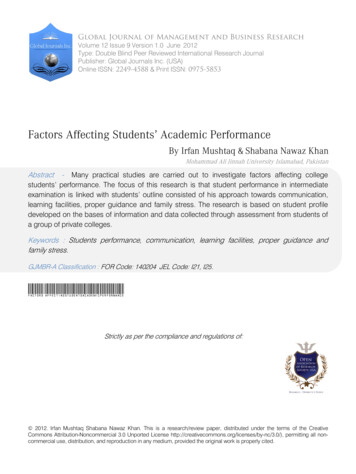




![05[2] Strategy competitors, competitive rivalry .](/img/2/052-strategy-competitors-competitive-rivalry-competitive-behavior-and-competitive-dynamics.jpg)
